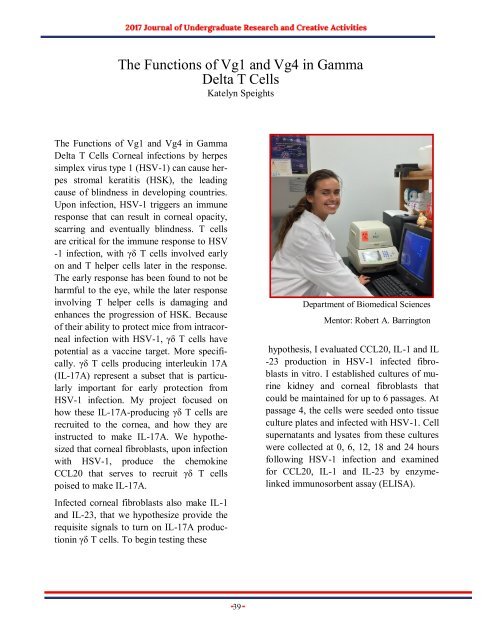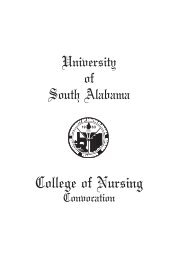JOURACA_SP_2017
Create successful ePaper yourself
Turn your PDF publications into a flip-book with our unique Google optimized e-Paper software.
The Functions of Vg1 and Vg4 in Gamma<br />
Delta T Cells<br />
Katelyn Speights<br />
The Functions of Vg1 and Vg4 in Gamma<br />
Delta T Cells Corneal infections by herpes<br />
simplex virus type 1 (HSV-1) can cause herpes<br />
stromal keratitis (HSK), the leading<br />
cause of blindness in developing countries.<br />
Upon infection, HSV-1 triggers an immune<br />
response that can result in corneal opacity,<br />
scarring and eventually blindness. T cells<br />
are critical for the immune response to HSV<br />
-1 infection, with γδ T cells involved early<br />
on and T helper cells later in the response.<br />
The early response has been found to not be<br />
harmful to the eye, while the later response<br />
involving T helper cells is damaging and<br />
enhances the progression of HSK. Because<br />
of their ability to protect mice from intracorneal<br />
infection with HSV-1, γδ T cells have<br />
potential as a vaccine target. More specifically.<br />
γδ T cells producing interleukin 17A<br />
(IL-17A) represent a subset that is particularly<br />
important for early protection from<br />
HSV-1 infection. My project focused on<br />
how these IL-17A-producing γδ T cells are<br />
recruited to the cornea, and how they are<br />
instructed to make IL-17A. We hypothesized<br />
that corneal fibroblasts, upon infection<br />
with HSV-1, produce the chemokine<br />
CCL20 that serves to recruit γδ T cells<br />
poised to make IL-17A.<br />
Infected corneal fibroblasts also make IL-1<br />
and IL-23, that we hypothesize provide the<br />
requisite signals to turn on IL-17A productionin<br />
γδ T cells. To begin testing these<br />
Department of Biomedical Sciences<br />
Mentor: Robert A. Barrington<br />
hypothesis, I evaluated CCL20, IL-1 and IL<br />
-23 production in HSV-1 infected fibroblasts<br />
in vitro. I established cultures of murine<br />
kidney and corneal fibroblasts that<br />
could be maintained for up to 6 passages. At<br />
passage 4, the cells were seeded onto tissue<br />
culture plates and infected with HSV-1. Cell<br />
supernatants and lysates from these cultures<br />
were collected at 0, 6, 12, 18 and 24 hours<br />
following HSV-1 infection and examined<br />
for CCL20, IL-1 and IL-23 by enzymelinked<br />
immunosorbent assay (ELISA).<br />
39

















